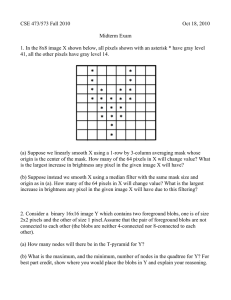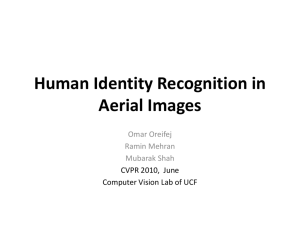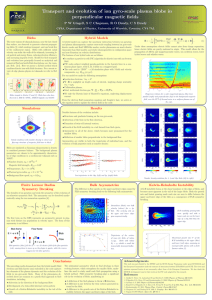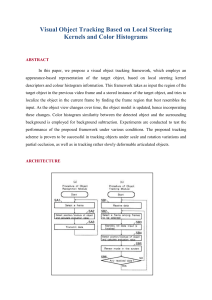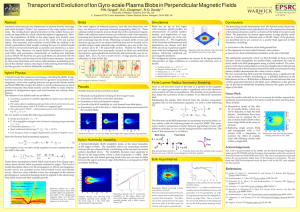LOW-LEVEL TRACKING OF MULTIPLE OBJECTS
advertisement
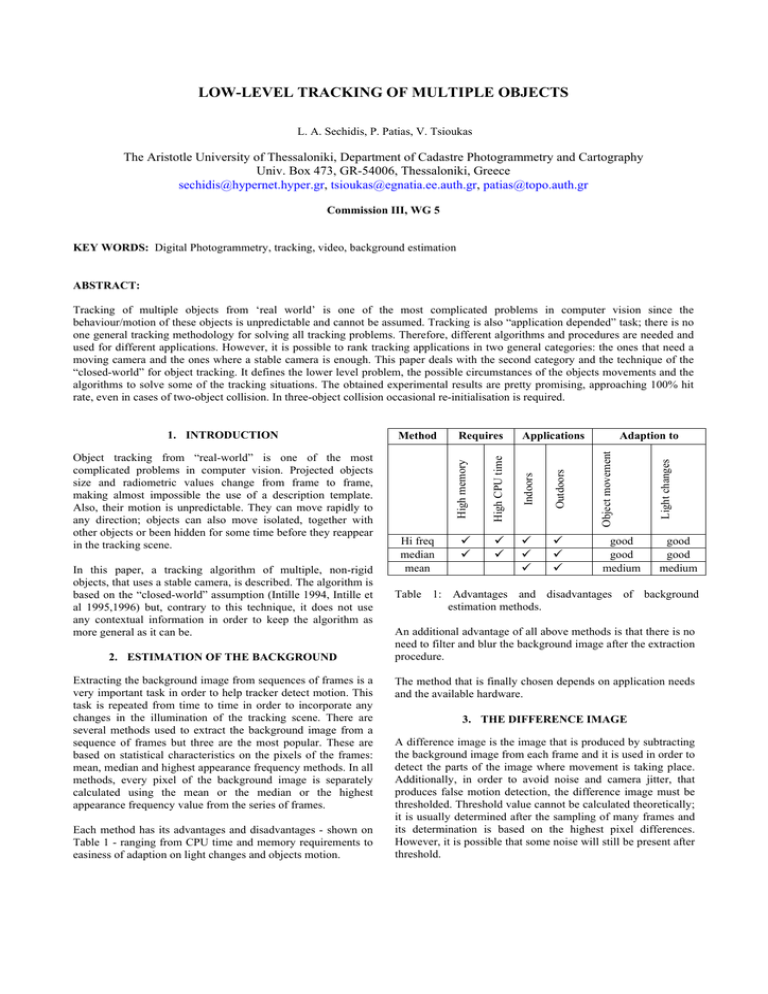
LOW-LEVEL TRACKING OF MULTIPLE OBJECTS
L. A. Sechidis, P. Patias, V. Tsioukas
The Aristotle University of Thessaloniki, Department of Cadastre Photogrammetry and Cartography
Univ. Box 473, GR-54006, Thessaloniki, Greece
sechidis@hypernet.hyper.gr, tsioukas@egnatia.ee.auth.gr, patias@topo.auth.gr
Commission III, WG 5
KEY WORDS: Digital Photogrammetry, tracking, video, background estimation
ABSTRACT:
Tracking of multiple objects from ‘real world’ is one of the most complicated problems in computer vision since the
behaviour/motion of these objects is unpredictable and cannot be assumed. Tracking is also “application depended” task; there is no
one general tracking methodology for solving all tracking problems. Therefore, different algorithms and procedures are needed and
used for different applications. However, it is possible to rank tracking applications in two general categories: the ones that need a
moving camera and the ones where a stable camera is enough. This paper deals with the second category and the technique of the
“closed-world” for object tracking. It defines the lower level problem, the possible circumstances of the objects movements and the
algorithms to solve some of the tracking situations. The obtained experimental results are pretty promising, approaching 100% hit
rate, even in cases of two-object collision. In three-object collision occasional re-initialisation is required.
2. ESTIMATION OF THE BACKGROUND
Extracting the background image from sequences of frames is a
very important task in order to help tracker detect motion. This
task is repeated from time to time in order to incorporate any
changes in the illumination of the tracking scene. There are
several methods used to extract the background image from a
sequence of frames but three are the most popular. These are
based on statistical characteristics on the pixels of the frames:
mean, median and highest appearance frequency methods. In all
methods, every pixel of the background image is separately
calculated using the mean or the median or the highest
appearance frequency value from the series of frames.
Each method has its advantages and disadvantages - shown on
Table 1 - ranging from CPU time and memory requirements to
easiness of adaption on light changes and objects motion.
Object movement
Light changes
9
9
Adaption to
Outdoors
9
9
Applications
Indoors
In this paper, a tracking algorithm of multiple, non-rigid
objects, that uses a stable camera, is described. The algorithm is
based on the “closed-world” assumption (Intille 1994, Intille et
al 1995,1996) but, contrary to this technique, it does not use
any contextual information in order to keep the algorithm as
more general as it can be.
Hi freq
median
mean
Requires
High CPU time
Object tracking from “real-world” is one of the most
complicated problems in computer vision. Projected objects
size and radiometric values change from frame to frame,
making almost impossible the use of a description template.
Also, their motion is unpredictable. They can move rapidly to
any direction; objects can also move isolated, together with
other objects or been hidden for some time before they reappear
in the tracking scene.
Method
High memory
1. INTRODUCTION
9
9
9
9
9
9
good
good
medium
good
good
medium
Table 1: Advantages and disadvantages of background
estimation methods.
An additional advantage of all above methods is that there is no
need to filter and blur the background image after the extraction
procedure.
The method that is finally chosen depends on application needs
and the available hardware.
3. THE DIFFERENCE IMAGE
A difference image is the image that is produced by subtracting
the background image from each frame and it is used in order to
detect the parts of the image where movement is taking place.
Additionally, in order to avoid noise and camera jitter, that
produces false motion detection, the difference image must be
thresholded. Threshold value cannot be calculated theoretically;
it is usually determined after the sampling of many frames and
its determination is based on the highest pixel differences.
However, it is possible that some noise will still be present after
threshold.
In general, if G(i,j) is the background image and F(i,j) any
single frame, then the difference image D(i,j) is calculated and
thresholded using the following formula:
{1if
D(i, j ) =
0 if F (i, j ) − G (i, j ) ≤ threshold
F (i, j ) − G (i, j ) > threshold
(1)
All pixels of the difference image that have value 1 include
motion and probably belong to an object, whereas the pixels
with value 0 are the same as the background and are ignored.
In color images, where there are usually three bands of color
information, the difference image can be calculated either
separated in each band or in a single grayscale band, which is
the combination of the three-color bands.
Figure 1: Moving objects in a difference image
from a basketball game
4. BLOBS AND OBJECTS
4.1 Blobs
Blobs have a long history in computer vision as a representation
of image features (Kauth et al 1977, Pentland 1976.). A blob
can be described as a set of connected pixels that share a
common attribute. This attribute can be any one of the color,
texture, brightness, shading or other salient spatio-temporal
attribute, derived from the image sequence, or any combination
of the above. In tracking, the common attribute is usually
motion.
All motion pixels in the difference image are clustered in blobs.
There are several techniques to cluster and extract blobs; most
common techniques are “meandering process” (Rossey, 1997)
and “connected pixels”. In our implementation we have used an
updated version of the popular image processing FILL
procedure; the implementation can extract blobs either from the
whole image or from a specific part of it.
After blob detection, every blob can be represented by its
properties; the most important of them are size, color and
position.
4.1.1 Size: The size N of a blob is the number of the pixels
that comprise the blob.
4.1.2 Color: The color Cm of a blob is the mean color of the
N pixels that comprise the blob.
N
cm =
∑ F (i , j )
1
(2)
N
It must be noticed here that the pixel color values F(i,j) are
taken from the original frame image.
4.1.3 Position: The position P(xm,ym) of a blob is the
geometric center of the N pixels that comprise the blob.
N
xm =
∑i
1
N
N
, ym =
∑j
1
N
(3)
4.2 Objects
Since objects create motion, difference image detects motion
and blobs are image features that describe motion, objects can
be described by blobs. One would expect that every object
could be described by only one blob but the common case is
that an object is comprised by more than one blobs, as shown in
image 2.
Figure 2: An object (basketball player) that is comprised
by two blobs (head and body).
Much like blobs, every object can be represented with its
properties such as color, size and position. These properties are
calculated just like the blob ones, with the difference that in
calculation all the actual blobs (and not their properties) are
used. Additionally, the object must have some more properties
to help tracking. The most important of these additional
properties is the bound box that includes all the blobs of the
object.
5. TRACKING ALGORITHM
The tracking algorithm uses two basic data structures:
1.
2.
A list of all active objects with their current properties
A history list that keeps all objects properties and
information about matching type and score in time
space.
The process of tracking follows the next steps:
1.
2.
3.
4.
5.
6.
7.
Initialization of the objects to be tracked
Prediction of objects future status
Find new objects in predicted positions
Matching of objects
Register objects with new properties
Update history list
Go to step 2 and repeat process
5.1 Prediction of new object status
In order to help tracker find the objects in a new frame, the
“expected status” of all objects is predicted. The “expected
status” includes all object’s main properties.
The most common technique to predict these properties is the
use of Kalman filters, technique that gives very good results.
Alternatively, if tracking speed is high (usually more than 5
FPS) and the speed of the objects is relatively low, the motion
of the objects can be assumed locally as linear and linear
interpolation can be used with very good results, too.
5.2 Collision detection
Since objects in “real world” applications can move
unexpectedly in the tracking scene, they can be projected
isolated or in touch with another or been hidden by some other.
And, since the tracking of isolated objects is much easier than
in other two situations, it is useful to help tracker predict in
which status the objects are. This task can be achieved by
predicting possible object collisions.
The property that is used to achieve collision detection is the
object’s bounding box. Every corner of each object’s box is
examined whether it is inside any other box. If any of the
corners are inside, the objects are in collision and the tracking
algorithm changes for these objects.
Three different collision stages may exist:
i.
An object is isolated
ii.
An object is collided with one or more but it’s blobs
are not in touch with other objects blobs
iii.
Object is collided with one or more and it’s blobs are
in touch with other object blobs, producing common
huge blobs
(a)
(b)
(c)
(d)
Figure 3: Collision stage ii (a & b) and iii (c & d). Images (a) &
(c) come from the original frame where images (b)
& (d) come from the difference image.
Unfortunately, collision detection procedure usually cannot
distinguish stage (ii) from (iii); this will be done later, during
object matching.
5.3 Assigning blobs to objects
For every object to be tracked (from now on it will be referred
as old object) a new one is created; it inherits all the properties
of the old one except it’s main properties. Then, the blobs that
exist into the expected bounding box are assigned to new object
- depended on old object’s expected collision stage - in order to
calculate the new main properties that will be used to identify if
two objects are similar.
If the old object is expected to be isolated, all blobs in expected
bounding box are assigned to the new object. Additionally,
from time to time, the expected bounding box can grow up in
order to avoid a bad prediction of its size or to re-estimate the
actual object size.
If the old object is expected to be in collision stage (ii) or (iii),
only the blobs in expected bounding box that their distance is
smaller than a distance threshold are assigned to the new object.
The others are dropped. The distance threshold value depends
on image scale and object mean size.
Blob dropping may help in distinguish two or more collided
objects but also leads to shrinking of the object’s actual size.
Therefore, it must be used with caution and only in collision
stages. Additionally, when the object comes to isolated stage in
later frames, its expected bounding box must grow up to reestimate object’s actual size.
After blob assignment, new object’s properties are calculated,
as described in §4.2, and object match procedure follows.
5.4 Matching an old object with the new one
The term matching has the meaning of identification. The new
object matches to old one if they are similar. If they do match,
the position (goal of tracking) of the old object in new frame
will be also the position of the new object.
Object main properties are used to calculate the similarity
between two objects. That is they are similar if
•
•
the weighted sum of color and size differences is
larger than a threshold AND
the distance between the two objects is lower than a
distance threshold.
s1 = pc (1 − (cn − co ) / cn ) , s2 = pN (1 − ( N n − N o ) / N n )
s = s12 + s 22
(4)
d = (i n − i o ) 2 + ( j n − j o ) 2
(5)
match if (s >t1) AND (d<t2)
(6)
where s = weighted sum
pc, pN = weights for color and size
cn, Nn = color and size of new object
co, No = color and size of old object OR predicted ones
in, jn = coordinates of new object
io, jo = coordinates of old object OR predicted ones
t1 = threshold
t2 = distance threshold
Parameters pc, pN and threshold t1 are application depended and
estimated after sampling on many frames. Threshold t2 depends
on object’s maximum speed vector.
There are two weighted sums that calculated:
− Between new and old object actual properties and
− Between new object and olds’ predicted properties.
The second weighted sum is very helpful when sudden or great
changes in color or size of the object happen. If any of the
above sums passes the threshold, the two objects are assumed
similar and the new object replaces the old one.
Additionally, separate comparisons are made on every property
and flag successful or failed individual matching.
The above matching formula (6) works with very good results
when object is isolated or in collision stage (ii). If object is in
stage (iii) (Fig3, c&d) then it’s size grows up suddenly with the
possibility that also its color differs a lot from previous frame;
the weighted sums then cannot pass the threshold and the
matching flag on size and possibly on color is failure. In this
case, matching fails and the position of the object is reestimated using an adaptive correlation matching procedure.
5.4.1
Adaptive correlation matching
The adaptive correlation matching is a variation of the classic
cross correlation technique. Their difference stands to the pixels
that participate in correlation. In adaptive correlation, only
pixels that belong to object’s blobs participate, as shown in fig.
4, in order to avoid background disturbance.
varied from 1: 130 up to 1:70 while the size of the objects
varied from 116 to 400 pixels. The color variation was different
for each object and was from 7 gray shades up to 40 (in extreme
cases), with a mean variation of 20 gray shades.
The parameters that were used for object identification
(matching) were:
pc : 0.60, pN : 0.40, t1 : 0.65, t2 : 15
6.2 Performance
The tracker managed to track all isolated objects in all frames
with no failure and collision stage (ii) objects with two failures.
In case of collision stage (iii) objects, tracker succeeded only on
two objects collision and in few cases on three objects, when
objects shared the same space for a short time period; In
general, it failed when more than two objects shared the same
space. In these cases re-initialization was performed.
7. CONCLUSIONS
(a)
(b)
Fig. 4: Correlation templates. (a) typical, (b) adaptive. White
pixels do not participate in correlation procedure.
The template of the object is created using the last frame in
which this object has been detected isolated or in stage (ii), with
the use of the history list. The search area is around object’s
predicted position in current frame and its data come from the
original frame.
As in typical correlation, it is possible that a lot of template
positions will have high correlation scores and the correct
object’s position is not that with the highest one; in this case,
the assumed correct position is the one with the minimum
distance from the predicted position. The object’s position is
updated in the current frame but its size and color retain their
values from the last frame.
If maximum correlation factor is very low, the matching fails;
But in this case, the following assumption is made:
•
If there are only two objects that are in stage (iii) then the
object is assumed hidden by the other; therefore, its
position is the position of the object that stands in front of
it.
•
If there are more than two objects in stage (iii) then it is
unknown which object hides the wanted one and the object
needs re-initialization in next frame.
Correlation match will work for a short range of sequent
frames. If an object is in stage (iii) for a long time, then its
shape will be very different after a number of frames from the
shape it had at the start of the sequence. Additionally, there will
be a drift on template center, as time passes (Intille, 1996).
Therefore, correlation matching must be used for a short time
period (for few frames).
6. TESTING THE ALGORITHM - PERFORMANCE
6.1 Example
The described tracking technique was tested on a 430 frames
video sequence of a basketball game, having 5 fps speed and
image size 768x576 pixels. The scale of the tracking scene
The described technique works very good when the objects do
not share the same blobs or only two objects are interacting. In
general, it suffers when more than two objects are in the same
space or the movement of the objects is rapid.
Since the tracking depends on correct interpreting of which
objects share the same blobs, in conjunction with objects
motion, current research is focused on this aspect.
REFERENCES
Gloyer, B., H. Aghajan, K.Y. Siu, T. Kailath, “Video based
Freeway monitoring System using Recursive Vehicle
Tracking”, Proc. IS&T/SPIE, Symposium on Electronic
Imaging, 1995
Intille , S, J, Davis, A, Bobick, “Real Time Closed-World
Tracking”, CCVPR, IEEE, 1996
Intille, S, A, Bobick, “Visual Tracking Using Closed Worlds”,
ICCV, IEEE, 1995
Intille, S., “Tracking Using a Local Closed World Assumption:
Tracking in the Footbal Domain”, Master Thesis , August 1994
Kauth, R.J, A.P. Pentland, G.S Tomas, “Blob: an unsupervised
clustering approach to spatial preprocessing of MSS imagery”,
XI Int. Symp. of RS of the Environment, Ann Arbor, MI, 1977
Ohno Y., J. Miura, Y. Shirai, “Tracking Players and Estimation
of the 3D Position of a ball in Soccer games”, ARIDA News
Letter #16,January 2000, pp. 3-6
Pentland, A, “Classification by clustering”, Proc of Symp on
MPRSD, IEEE Computer Society Press, 1976
Rossey, L, “Design and Implementation of Opinion-Based
Behaviors for an Autonomous Mobile Robot with Vision”,
Master Thesis, 1997
Wren , C., A. Azarbayejani, T. Darrell, A. Pentland, “Pfinder :
Real-Time Tracking of the Human Body”, TPAMI, IEEE, vol.
19,no 7, pp. 780-785
